Black-tailed Godwits in the EAAF
In collaboration with Beijing Normal University, we study Black-tailed Godwits who stage in Bohai Bay (China) and migrate to still unexplored breeding areas in Mongolia and Russia. This project is led by PhD student Bingrun Zhu, under the supervision of Profs. Zhang Zhengwang (Beijing Normal University) and Theunis Piersma.
[caption id="attachment_1895" align="alignnone" width="435"]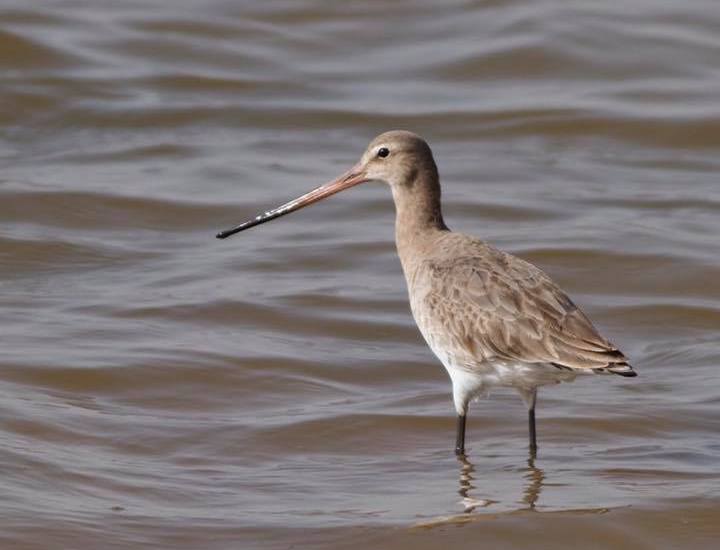 A Black-tailed Godwit of the melanuroides subspecies. Photo: Bingrun Zhu[/caption]
A Black-tailed Godwit of the melanuroides subspecies. Photo: Bingrun Zhu[/caption]
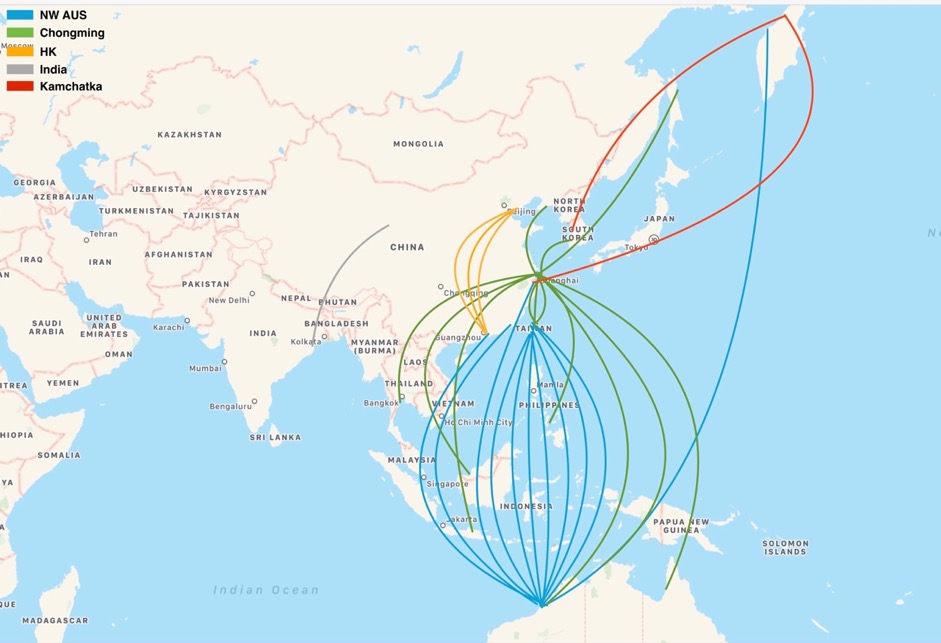 Resightings of Black-tailed Godwits between 1997 and 2017[/caption]
There is very little knowledge about this Bohai birds: where do they come from (which wintering grounds) and where are they heading to (which breeding grounds)? As a community we have collected more than 40 resightings along the EAAF, and only three showed a connection between Maipo Wetland in Hong Kong and Bohai Bay, not even one of the Bohai godwits was connected with Northwest Australia, which is the main wintering ground of melanuroides Black-tailed Godwits – the only described subspecies in this flyway. Furthermore, morphologically, the population that appears in Bohai Bay have thicker and longer bills, larger body sizes and paler plumage than the described melanuroides godwits.
Therefore in 2014 we started a project to compare the differences between the Black-tailed Godwits in Bohai Bay and other populations of the melanuroides subspecies. We study their migration strategies and breeding ecology. The project is funded by Air and Water Conservation Fund (National Geography) and National Natural Science Foundation (China).
[caption id="attachment_3118" align="alignnone" width="491"]
Resightings of Black-tailed Godwits between 1997 and 2017[/caption]
There is very little knowledge about this Bohai birds: where do they come from (which wintering grounds) and where are they heading to (which breeding grounds)? As a community we have collected more than 40 resightings along the EAAF, and only three showed a connection between Maipo Wetland in Hong Kong and Bohai Bay, not even one of the Bohai godwits was connected with Northwest Australia, which is the main wintering ground of melanuroides Black-tailed Godwits – the only described subspecies in this flyway. Furthermore, morphologically, the population that appears in Bohai Bay have thicker and longer bills, larger body sizes and paler plumage than the described melanuroides godwits.
Therefore in 2014 we started a project to compare the differences between the Black-tailed Godwits in Bohai Bay and other populations of the melanuroides subspecies. We study their migration strategies and breeding ecology. The project is funded by Air and Water Conservation Fund (National Geography) and National Natural Science Foundation (China).
[caption id="attachment_3118" align="alignnone" width="491"]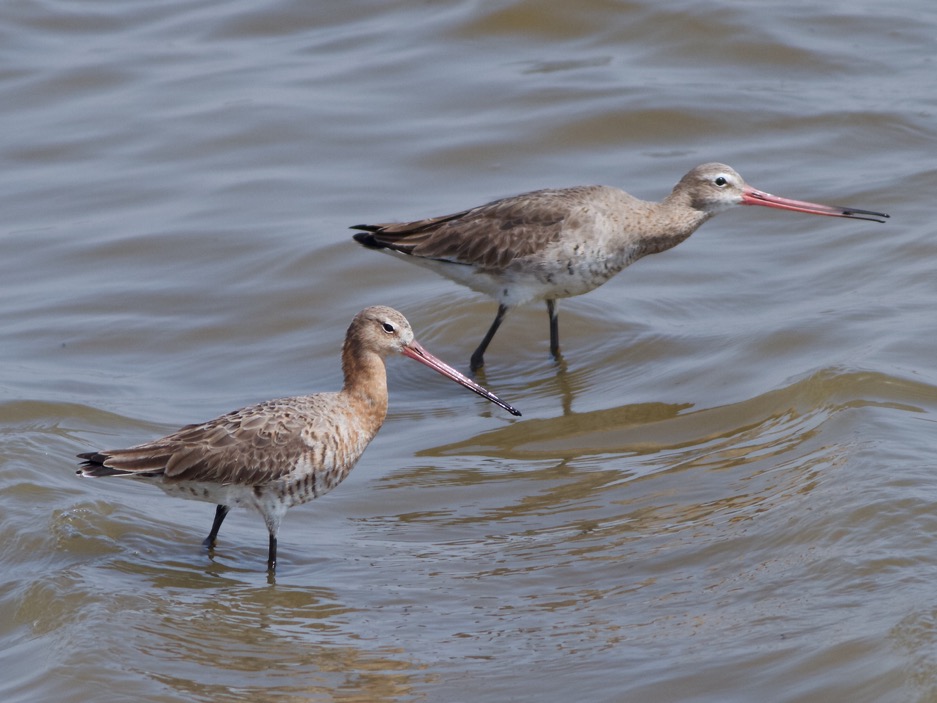 Black-tailed godwits (male at left & female at right) foraging in saltpan of Tangshan, China. Photo: Bingrun Zhu[/caption]
[caption id="attachment_3119" align="alignnone" width="498"]
Black-tailed godwits (male at left & female at right) foraging in saltpan of Tangshan, China. Photo: Bingrun Zhu[/caption]
[caption id="attachment_3119" align="alignnone" width="498"]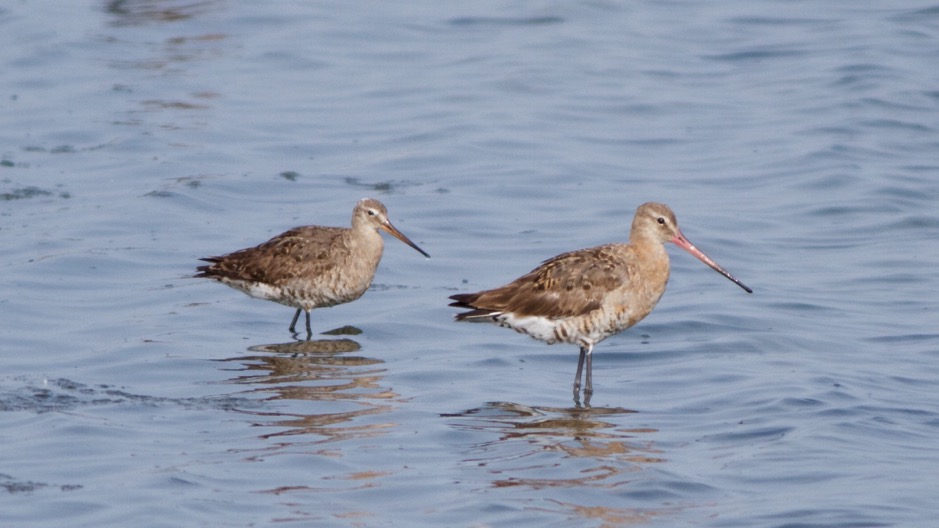 Illustration of the two different sizes of Black-tailed Godwits that appear in Tangshan. Photo: Bingrun Zhu[/caption]
Trapping and satellite Tracking
Catching Black-tailed Godwits at a stop-over site, especially in Bohai Bay, is time- and energy consuming work. Godwits normally land rapidly from high altitude and have excellent eyesight, plus they choose massive open saltpans (1-2 km2) to stay overnight and move erratic with the wind direction, making it is extremely difficult to predict where to successfully catch godwits.
[caption id="attachment_1896" align="alignnone" width="361"]
Illustration of the two different sizes of Black-tailed Godwits that appear in Tangshan. Photo: Bingrun Zhu[/caption]
Trapping and satellite Tracking
Catching Black-tailed Godwits at a stop-over site, especially in Bohai Bay, is time- and energy consuming work. Godwits normally land rapidly from high altitude and have excellent eyesight, plus they choose massive open saltpans (1-2 km2) to stay overnight and move erratic with the wind direction, making it is extremely difficult to predict where to successfully catch godwits.
[caption id="attachment_1896" align="alignnone" width="361"]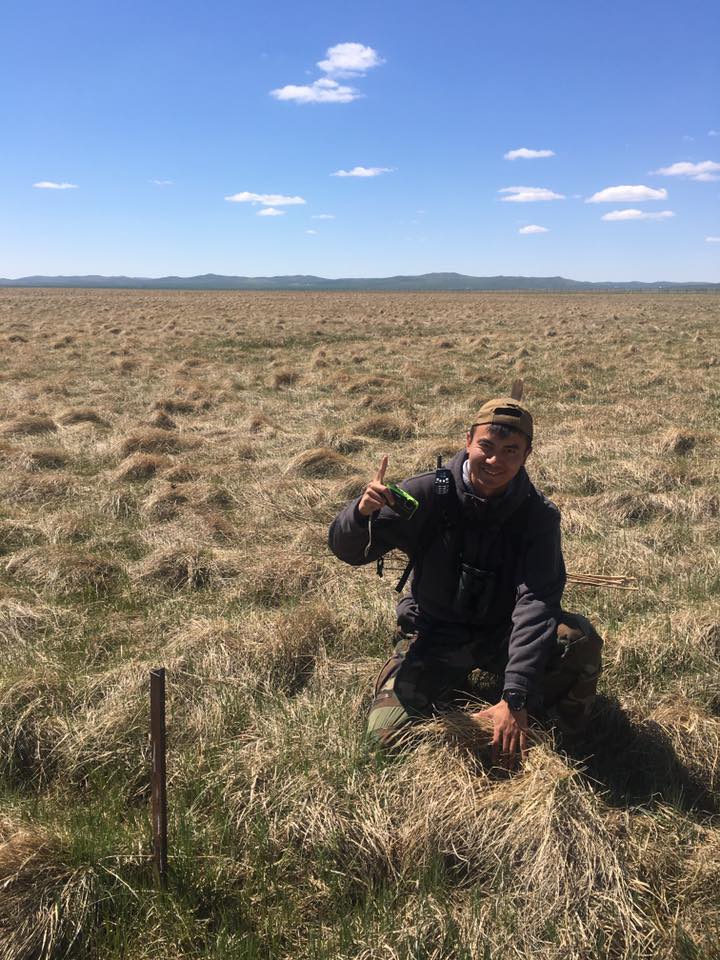 Bingrun Zhu finds his first nest in Mongolia in 2016. Photo: Bingrun Zhu[/caption]
Since 2016, by setting multiple trap types (mist nets, clap nets and noose mats), I started to catch and tag Black-tailed Godwits in Bohai Bay with the help of colleagues, friends and volunteers. Using lightest Chinese GSM/GPS transmitter (manufactured by Huan Qiu Xin Shi, 9 gram), I would get an update of the movements of tagged individuals every 3 hours. From these tracks, I’ve successfully found the breeding grounds of the Bohai godwits in Sakha Republic, Russia, yet in 2016 their wintering grounds remained unknown due to a failure of tags during south-ward tracking season. Check our blog for updates.
[caption id="attachment_3121" align="alignnone" width="390"]
Bingrun Zhu finds his first nest in Mongolia in 2016. Photo: Bingrun Zhu[/caption]
Since 2016, by setting multiple trap types (mist nets, clap nets and noose mats), I started to catch and tag Black-tailed Godwits in Bohai Bay with the help of colleagues, friends and volunteers. Using lightest Chinese GSM/GPS transmitter (manufactured by Huan Qiu Xin Shi, 9 gram), I would get an update of the movements of tagged individuals every 3 hours. From these tracks, I’ve successfully found the breeding grounds of the Bohai godwits in Sakha Republic, Russia, yet in 2016 their wintering grounds remained unknown due to a failure of tags during south-ward tracking season. Check our blog for updates.
[caption id="attachment_3121" align="alignnone" width="390"]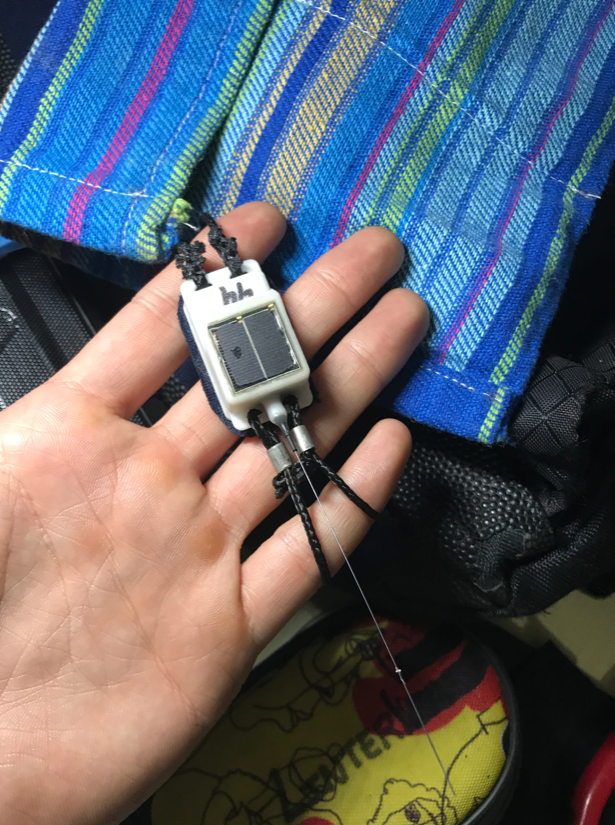 GSM/GPS Transmitter (HQBN2009s, 9g). Photo: Bingrun Zhu[/caption]
[caption id="attachment_3122" align="alignnone" width="390"]
GSM/GPS Transmitter (HQBN2009s, 9g). Photo: Bingrun Zhu[/caption]
[caption id="attachment_3122" align="alignnone" width="390"]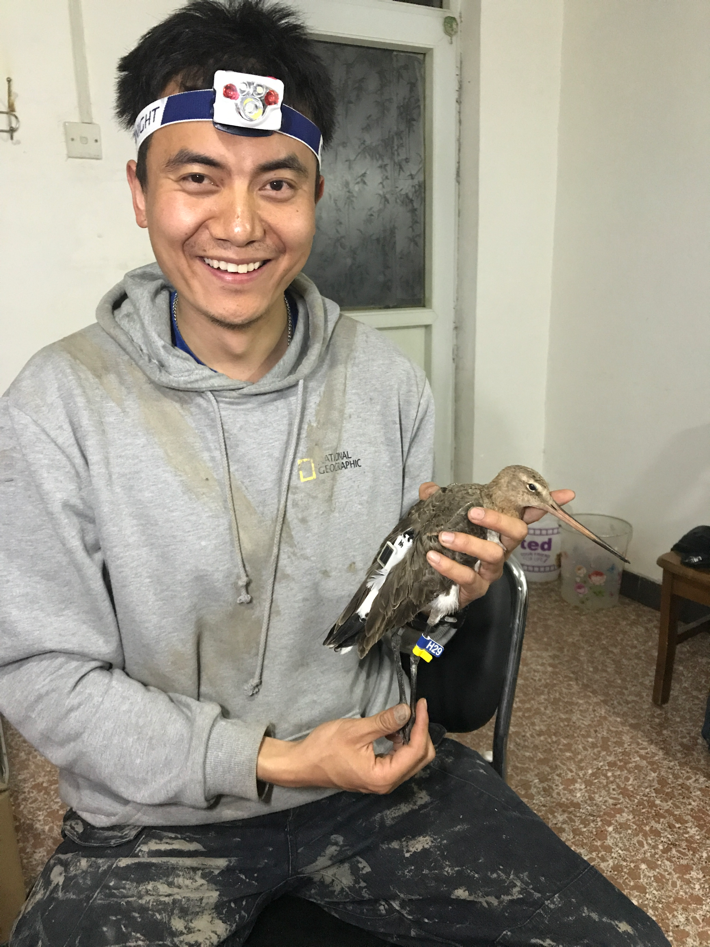 Bingrun Zhu and 1st tagged birds in 2017. Photo: Li Guofu[/caption]
Bingrun Zhu and 1st tagged birds in 2017. Photo: Li Guofu[/caption]
 A Black-tailed Godwit of the melanuroides subspecies. Photo: Bingrun Zhu[/caption]
A Black-tailed Godwit of the melanuroides subspecies. Photo: Bingrun Zhu[/caption]
Background
Black-tailed Godwits are widely distributed in Eurasia. More than 10,000 godwits stage in the northern part of Bohai Bay in China – Hangu, Tianjin and Nanpu, Tangshan coast during spring – to refuel at saltpans and mudflats. Their staging period lasts about 45 days (from beginning of April till the middle of May). Whereas the small-bodied melanuroides was thought to be the only subspecies occurring in the East Asian-Australasian Flyway (EAAF), over the last decade there have been observations by Chris Hassell, Adrian Boyle and J. Hollock of Black-tailed Godwits in Bohai Bay similar in size to limosa, i.e. with rather long and thick bills and a paler plumage compared with the smaller co-occurring Godwits (thought to be melanuroides). Also Katherine Leung in the Mai Po Wetland of Hong Kong reported large godwits between August and March. This got the ball rolling. [caption id="attachment_3120" align="alignnone" width="587"] Resightings of Black-tailed Godwits between 1997 and 2017[/caption]
There is very little knowledge about this Bohai birds: where do they come from (which wintering grounds) and where are they heading to (which breeding grounds)? As a community we have collected more than 40 resightings along the EAAF, and only three showed a connection between Maipo Wetland in Hong Kong and Bohai Bay, not even one of the Bohai godwits was connected with Northwest Australia, which is the main wintering ground of melanuroides Black-tailed Godwits – the only described subspecies in this flyway. Furthermore, morphologically, the population that appears in Bohai Bay have thicker and longer bills, larger body sizes and paler plumage than the described melanuroides godwits.
Therefore in 2014 we started a project to compare the differences between the Black-tailed Godwits in Bohai Bay and other populations of the melanuroides subspecies. We study their migration strategies and breeding ecology. The project is funded by Air and Water Conservation Fund (National Geography) and National Natural Science Foundation (China).
[caption id="attachment_3118" align="alignnone" width="491"]
Resightings of Black-tailed Godwits between 1997 and 2017[/caption]
There is very little knowledge about this Bohai birds: where do they come from (which wintering grounds) and where are they heading to (which breeding grounds)? As a community we have collected more than 40 resightings along the EAAF, and only three showed a connection between Maipo Wetland in Hong Kong and Bohai Bay, not even one of the Bohai godwits was connected with Northwest Australia, which is the main wintering ground of melanuroides Black-tailed Godwits – the only described subspecies in this flyway. Furthermore, morphologically, the population that appears in Bohai Bay have thicker and longer bills, larger body sizes and paler plumage than the described melanuroides godwits.
Therefore in 2014 we started a project to compare the differences between the Black-tailed Godwits in Bohai Bay and other populations of the melanuroides subspecies. We study their migration strategies and breeding ecology. The project is funded by Air and Water Conservation Fund (National Geography) and National Natural Science Foundation (China).
[caption id="attachment_3118" align="alignnone" width="491"] Black-tailed godwits (male at left & female at right) foraging in saltpan of Tangshan, China. Photo: Bingrun Zhu[/caption]
[caption id="attachment_3119" align="alignnone" width="498"]
Black-tailed godwits (male at left & female at right) foraging in saltpan of Tangshan, China. Photo: Bingrun Zhu[/caption]
[caption id="attachment_3119" align="alignnone" width="498"] Illustration of the two different sizes of Black-tailed Godwits that appear in Tangshan. Photo: Bingrun Zhu[/caption]
Trapping and satellite Tracking
Catching Black-tailed Godwits at a stop-over site, especially in Bohai Bay, is time- and energy consuming work. Godwits normally land rapidly from high altitude and have excellent eyesight, plus they choose massive open saltpans (1-2 km2) to stay overnight and move erratic with the wind direction, making it is extremely difficult to predict where to successfully catch godwits.
[caption id="attachment_1896" align="alignnone" width="361"]
Illustration of the two different sizes of Black-tailed Godwits that appear in Tangshan. Photo: Bingrun Zhu[/caption]
Trapping and satellite Tracking
Catching Black-tailed Godwits at a stop-over site, especially in Bohai Bay, is time- and energy consuming work. Godwits normally land rapidly from high altitude and have excellent eyesight, plus they choose massive open saltpans (1-2 km2) to stay overnight and move erratic with the wind direction, making it is extremely difficult to predict where to successfully catch godwits.
[caption id="attachment_1896" align="alignnone" width="361"] Bingrun Zhu finds his first nest in Mongolia in 2016. Photo: Bingrun Zhu[/caption]
Since 2016, by setting multiple trap types (mist nets, clap nets and noose mats), I started to catch and tag Black-tailed Godwits in Bohai Bay with the help of colleagues, friends and volunteers. Using lightest Chinese GSM/GPS transmitter (manufactured by Huan Qiu Xin Shi, 9 gram), I would get an update of the movements of tagged individuals every 3 hours. From these tracks, I’ve successfully found the breeding grounds of the Bohai godwits in Sakha Republic, Russia, yet in 2016 their wintering grounds remained unknown due to a failure of tags during south-ward tracking season. Check our blog for updates.
[caption id="attachment_3121" align="alignnone" width="390"]
Bingrun Zhu finds his first nest in Mongolia in 2016. Photo: Bingrun Zhu[/caption]
Since 2016, by setting multiple trap types (mist nets, clap nets and noose mats), I started to catch and tag Black-tailed Godwits in Bohai Bay with the help of colleagues, friends and volunteers. Using lightest Chinese GSM/GPS transmitter (manufactured by Huan Qiu Xin Shi, 9 gram), I would get an update of the movements of tagged individuals every 3 hours. From these tracks, I’ve successfully found the breeding grounds of the Bohai godwits in Sakha Republic, Russia, yet in 2016 their wintering grounds remained unknown due to a failure of tags during south-ward tracking season. Check our blog for updates.
[caption id="attachment_3121" align="alignnone" width="390"] GSM/GPS Transmitter (HQBN2009s, 9g). Photo: Bingrun Zhu[/caption]
[caption id="attachment_3122" align="alignnone" width="390"]
GSM/GPS Transmitter (HQBN2009s, 9g). Photo: Bingrun Zhu[/caption]
[caption id="attachment_3122" align="alignnone" width="390"] Bingrun Zhu and 1st tagged birds in 2017. Photo: Li Guofu[/caption]
Bingrun Zhu and 1st tagged birds in 2017. Photo: Li Guofu[/caption]